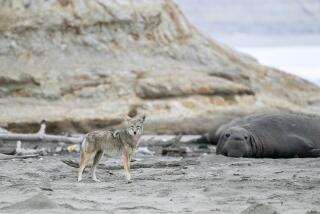Wonder of Seals and Their Cousins : THE PINNIPEDS: SEALS, SEA LIONS, AND WALRUSES<i> by Marianne Riedman</i> University of California Press $29.95, 439 pages
- Share via
Before reading “The Pinnipeds,” my knowledge of seals was limited to what I had seen in animal acts and zoos. In other words, not very much.
Now that I’ve read this intriguing book, I have discovered what amazing and adaptable beasts they are: able to live at sea and on land, in extreme environments from the polar ice caps to the tropics, and to do things that sound impossible.
They are mammals, but they can dive to several thousand feet under water. They can go without eating for weeks or months at a time. They are friendly, playful, socially organized and capable of learning complex tasks.
The navy has taught them to attach lines to missiles under water. The New York police are teaching them to retrieve handguns tossed into rivers. “Instead of police dogs, there will be police seals,” says Marianne Riedman, the author. No wonder they do so well in circuses.
She writes: “When we put aside science for a moment and--for the pure pleasure of watching--observe a harbor seal gliding effortlessly among quiet kelp forests or playful young sea lions frolicking together and bodysurfing, our appreciation and respect for these marvelous mammals is renewed and deepened. We cannot help being enchanted by their beauty and ease and strength.”
Though “The Pinnipeds” is a somewhat scholarly book--befitting a university press--it is not dry, and it is chock-a-block with pictures that capture the essence of the text and the charm of the seals. (The word pinniped , by the way, means fin-footed, and it speaks to the amphibious nature of these animals, who swim with their fins in water and walk on them on land.)
Much of the material here on the natural history of seals is relatively new knowledge gathered by many researchers and the author herself in numerous field trips. There are 33 known species of pinnipeds, and much about them is still a mystery. As I’ve indicated, virtually everything about them was new to me, which doesn’t mean anything except that I’ve been looking elsewhere and hadn’t noticed the seals before.
The bibliography fills more than 50 pages, which shows that somebody’s been studying these creatures, though Riedman may be the first to pull the material together in a comprehensive and accessible way.
As you’d expect, Riedman’s book covers the basic elements of the evolution, biology and life strategies of seals, including their diet, mating systems, breeding behavior, maternal care and such, all presented in rich detail.
Riedman offers some speculation about seals’ ability to communicate with each other and with humans. She says that like chimpanzees and dolphins, they can be taught to use a few English words, and, she says, they can even bark them, sort of. Or, at least some people think they can.
“No one has yet demonstrated that a nonhuman animal possesses all the attributes of human language,” Riedman says. But she then offers evidence of seals’ rudimentary use of words.
Hoover is a harbor seal at the New England Aquarium. “When Hoover was 7 years old, he was first heard to ‘talk’ with humans. According to one observer, ‘He says “Hoover” in plain English. I have witnesses.’ Hoover also mimicked other words or phrases, such as ‘hello,’ ‘hello there,’ ‘hey,’ ‘how are you,’ ‘get out of there (here),’ ‘come out of here.’ These same words were often repeated by humans caring for the seals.”
Of course, these words were slurred and not well modulated. One group of researchers “felt that Hoover’s human speech sounded like that of a male human with a Boston accent. In addition, he often sounded a bit drunk.”
What to make of this? The publisher should include a tape with the book so readers can listen and decide for themselves. I am quite eager to hear a seal who sounds like a drunk Bostonian.
The speculation about language leads Riedman to wonder about seal consciousness and how they view the world and think about it. She quickly concedes that we can never know, but she notes that the question is always lurking in the background when we deal with animals that are obviously intelligent and aware of things in a way that is familiar to us.
Not only was I fascinated by most of the book, but I’m fascinated that I was fascinated, as animal books are not usually my first choice in reading. Perhaps it is because I knew so little about these animals at the outset that I was surprised and intrigued by what I learned as I went along.
Next: Jonathan Kirsch reviews “Thunder at Twilight” by Frederic Morton (Scribner’s).
More to Read
Sign up for our Book Club newsletter
Get the latest news, events and more from the Los Angeles Times Book Club, and help us get L.A. reading and talking.
You may occasionally receive promotional content from the Los Angeles Times.










